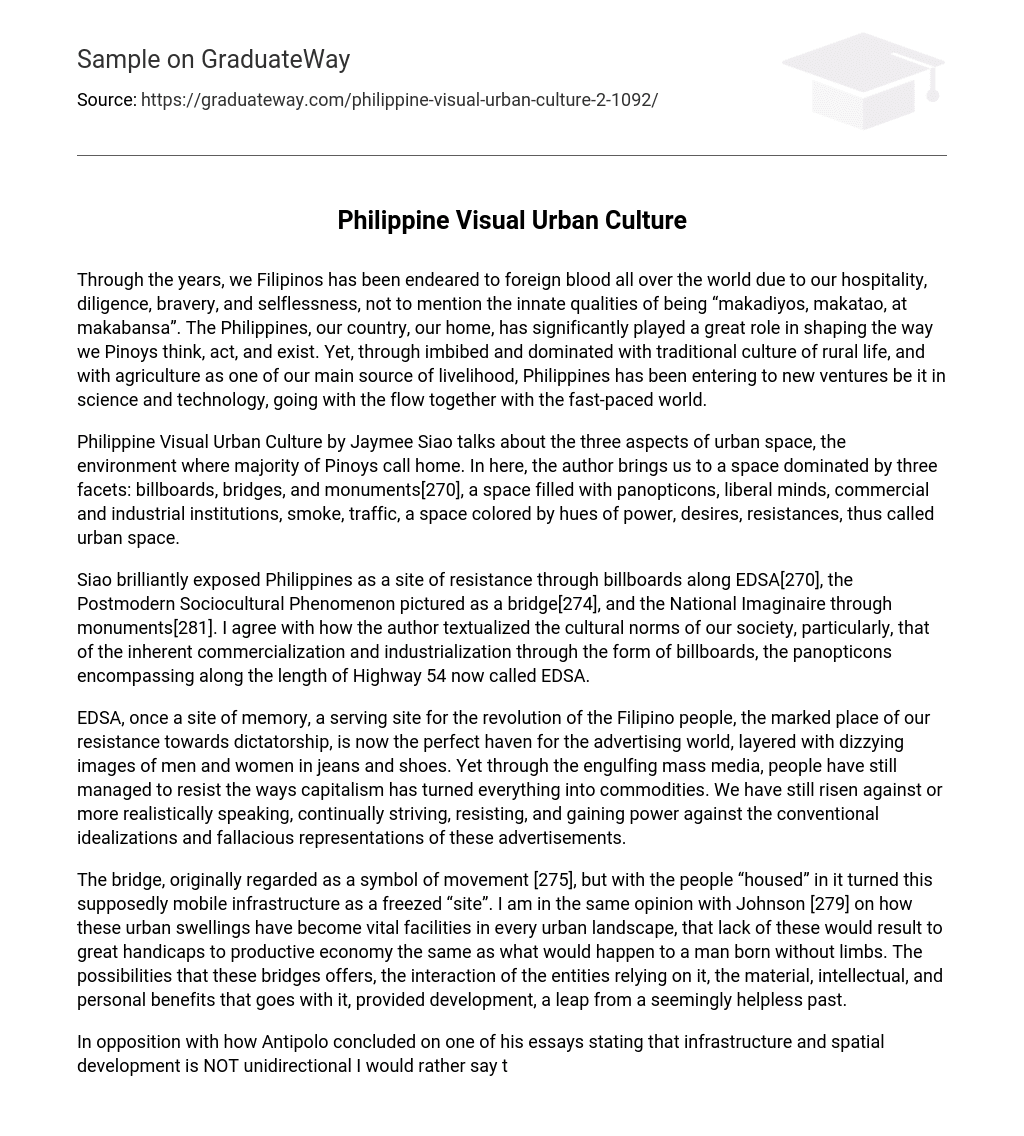Filipinos have gained global admiration for their hospitality, diligence, bravery, and selflessness over the years. We are also recognized for our inherent qualities of being “God-fearing, humane, and patriotic”. The Philippines, our beloved country and home, has deeply impacted our mindset, actions, and existence as Pinoys. Although we maintain a strong bond with rural life and depend on agriculture for sustenance, the Philippines has also embraced advancements in science and technology to stay updated with rapidly changing worldwide trends.
In the essay “Philippine Visual Urban Culture” by Jaymee Siao, the author explores the various elements of urban space in the Philippines. This environment serves as the home for many Filipinos and is characterized by three key features: billboards, bridges, and monuments. Within this space, there is a proliferation of panopticons, liberal thinking, commercial and industrial establishments, smoke, and traffic. It is a space that reflects a mix of power dynamics, desires, and resistance, which is why it is commonly referred to as urban space.
Siao effectively showcased the Philippines as a space of rebellion through various means, such as billboards along EDSA[270], the representation of Postmodern Sociocultural Phenomenon as a bridge[274], and monuments that embody the National Imaginaire[281]. I concur with the author’s interpretation of our society’s cultural values, specifically regarding the widespread commercialization and industrialization evident in the proliferation of billboards. These billboards serve as panopticons, spanning the entirety of Highway 54, now known as EDSA.
EDSA, formerly a site of historical significance and a symbol of the Filipino people’s revolution, has now transformed into a popular destination for the advertising industry. The streets are adorned with countless images of individuals wearing jeans and shoes, creating a disorienting display. However, despite the pervasive influence of mass media, people have managed to push back against the capitalist agenda of turning everything into merchandise. We continue to resist and make progress in challenging the conventional notions and misleading portrayals presented by these advertisements.
The bridge was originally considered a symbol of movement [275]. However, when people started living on the bridge, it transformed from a mobile infrastructure into a stagnant “site”. I agree with Johnson [279], who argues that these urban expansions have become essential facilities in every city. Without them, the productive economy would be greatly handicapped, similar to a person born without limbs. These bridges offer various possibilities and facilitate interactions among different entities. They bring material, intellectual, and personal benefits, leading to development and a significant shift from a seemingly helpless past.
Contrary to Antipolo’s essay conclusion that infrastructure and spatial development is not unidirectional, I believe it is actually directly proportional. Development and facilities lead to liberation and subsequently freedom. I question Siao’s incorrect conceptualization that unlike Egypt, China, and Rome, the Philippines lacks monumental works to boast of [281]. I also disagree with his statement that the Spaniards came to civilize the Filipinos [283].
Before the mestizos arrived and conquered our land, our Filipino ancestors had already been creating monuments known as “anitos” – wooden idols of their god, Bathala. They possessed not only a talent for farming but also exceptional craftsmanship, skillfully shaping stones into remarkable statues and ancient monuments dedicated to their gods. While it is undeniably true that the Spaniards introduced Christianity and successfully converted our ancestors who previously followed pagan/nature-based beliefs, it is important to acknowledge that our forebearers had already been leading civilized lives on their own terms.
Despite being colonized by the Spaniards and Americans, the influence of their presence is still apparent in our culture. The essence they brought can still be sensed in our streets, homes, and within us. Although our recollections of this era may be fading away, they will forever remain imprinted in our hearts. Monuments were constructed to safeguard our identity and history, acting as prompts for us to delve into and comprehend our past. They serve as a testament to our aspiration of establishing a nation that is authentically ours.
The billboards, bridges, and monuments all contribute to our understanding and appreciation of Filipino heritage and culture. These elements are prominently displayed in urban spaces, the streets we traverse, and the daily traffic jams and pollution we encounter. These aspects unconsciously become a part of our identity, enhancing our true Filipino spirit.





